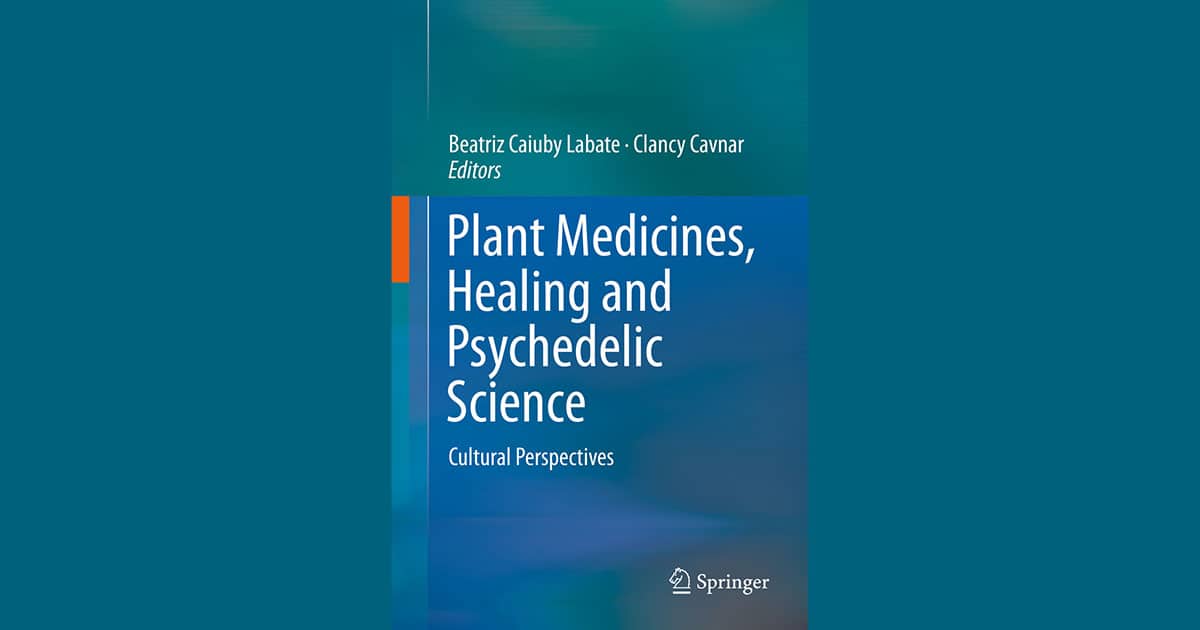- Rethinking Power, Plants, and the Future of Psychedelic Culture - May 9, 2025
- Where Is the Psychedelic Movement Headed Next? - October 15, 2024
- The FDA’s Rejection on MDMA-Assisted Therapy: What is Next for the Psychedelic Movement? - August 16, 2024
- Queering Psychedelics: An Introduction - August 7, 2024
- Introduction to Women and Psychedelics - July 26, 2024
- Eight Frequently Asked Questions About Ayahuasca Globalization - February 13, 2024
Beatriz Caiuby Labate & Clancy Cavnar (Eds).
To buy at Springer click here
See also
Abstract:
This is a book about the intersections of three dimensions. The first is the way social scientists and historians treat the history of psychiatry and healing, especially as it intersects with psychedelics. The second encompasses a reflection on the substances themselves and their effects on bodies. The third addresses traditional healing, as it circles back to our understanding of drugs and psychiatry. The chapters explore how these dimensions are distinct, but deeply intertwined, themes that, in turn, offer important insights into contemporary healing practices.
Co-editors Biographies:
Beatriz Caiuby Labate has a Ph.D. in social anthropology from the State University of Campinas (UNICAMP), Brazil. Her main areas of interest are the study of psychoactive substances, drug policy, shamanism, ritual, and religion. She is Adjunct Faculty at the East-West Psychology Program at the California Institute of Integral Studies (CIIS) in San Francisco and Visiting Professor at the Center for Research and Post Graduate Studies in Social Anthropology (CIESAS) in Guadalajara. She is co-founder of the Drugs, Politics, and Culture Collective, in Mexico (http://drogaspoliticacultura.net), and co-founder of the Interdisciplinary Group for Psychoactive Studies (NEIP) in Brazil, as well as editor of NEIP’s website (http://www.neip.info). She is also Chief Editor at Chacruna (https://chacruna.net). She is author, co-author, and co-editor of eighteen books, one special-edition journal, and several peer-reviewed articles (http://bialabate.net).
Clancy Cavnar has a doctorate in clinical psychology (Psy.D.) from John F. Kennedy University in Pleasant Hill, CA. She currently works in private practice in San Francisco, and is an associate editor at Chacruna (https://chacruna.net), a venue for publication of high-quality academic short texts on plant medicines. She is also a research associate of the Interdisciplinary Group for Psychoactive Studies (NEIP). She combines an eclectic array of interests and activities as clinical psychologist, artist, and researcher. She has a master of fine arts in painting from the San Francisco Art Institute, a master’s in counseling from San Francisco State University, and she completed the Certificate in Psychedelic-Assisted Therapy program at the California Institute of Integral Studies (CIIS). She is author and co-author of articles in several peer-reviewed journals and co-editor, with Beatriz Caiuby Labate, of eight books. For more information see: http://neip.info/pesquisadore/clancy-cavnar
Table of contents
Introduction
Beatriz Caiuby Labate, Clancy Cavnar & Alexander Dawson
Background: This book is a result of the conference Psychedelic Science 2017, held in Oakland, 19- 24 April 2017. The conference was organized in three simultaneous tracks: Clinical Research, Interdisciplinary Research, and Plant Medicines. Beatriz Caiuby Labate was the curator of the Plant Medicine Track.
- Who is Keeping Tabs? LSD Lessons from the Past
Erika Dyck
Psychedelics fell from medical grace nearly half a century 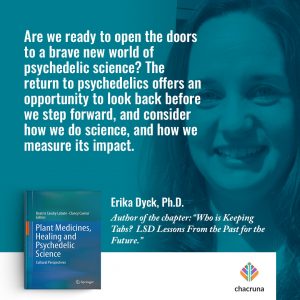 ago, but recent activity suggests that some researchers have “high hopes” for their return. Are we at risk, however, of facing the same historic challenges with a new generation of psychedelic enthusiasts, or have the circumstances changed sufficiently to allow for a new path forward? The twenty-first-century incarnation of psychedelic research resurrects some anticipated hypotheses, and explores some of the same applications that clinicians experimented with fifty years ago. On the surface, then, the psychedelic renaissance might be dismissed for retreading familiar ground. A deeper look at the context that gave rise to these questions, though, suggests that, while some of the questions are common, the culture of neuroscience and the business of drug regulation have changed sufficiently to warrant a retrial. Historically, LSD and its psychedelic cousins were not simply victims of unsophisticated science; drug regulators arguably squeezed them out of legitimate existence based on assumptions about their perceived dangers, side effects, and potential for abuse. I examine the historical clinical uses of LSD in Canada, including the facility that led to the coining of the term “psychedelic,” and the infamous Hollywood Hospital that offered psychedelic treatments for addictions, to explore some of the lessons that a close reading of LSD’s past has to offer.
ago, but recent activity suggests that some researchers have “high hopes” for their return. Are we at risk, however, of facing the same historic challenges with a new generation of psychedelic enthusiasts, or have the circumstances changed sufficiently to allow for a new path forward? The twenty-first-century incarnation of psychedelic research resurrects some anticipated hypotheses, and explores some of the same applications that clinicians experimented with fifty years ago. On the surface, then, the psychedelic renaissance might be dismissed for retreading familiar ground. A deeper look at the context that gave rise to these questions, though, suggests that, while some of the questions are common, the culture of neuroscience and the business of drug regulation have changed sufficiently to warrant a retrial. Historically, LSD and its psychedelic cousins were not simply victims of unsophisticated science; drug regulators arguably squeezed them out of legitimate existence based on assumptions about their perceived dangers, side effects, and potential for abuse. I examine the historical clinical uses of LSD in Canada, including the facility that led to the coining of the term “psychedelic,” and the infamous Hollywood Hospital that offered psychedelic treatments for addictions, to explore some of the lessons that a close reading of LSD’s past has to offer.
Watch the presentation by Erika Dyck at Psychedelic Science 2017 here
- Peyote’s Race Problem
Alexander Dawson
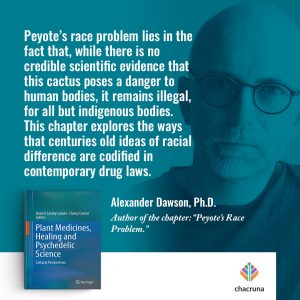 In the years since peyote became a controlled substance in Mexico and the US, a steady stream of advocates and activists have laid claim to two types of exemption, rooted in both US Law (the First Amendment) and International Law (the 1971 Vienna Convention on Psychotropic Drugs). Indigenous peyotists in particular have been largely successful in making a claim to a legal right to be exempt from national prohibitions on peyote possession and consumption. This has represented a significant advance in indigenous rights, yet in both contexts it has had the unpleasant effect of signaling that a drug that is otherwise so dangerous as to be prohibited should be permitted for Indians, because they are somehow essentially different from all other citizens. This, then, is Peyote’s Race Problem. The ways in which we have created a legal framework that makes peyote use licit among indigenous peoples has hardened a certain notion of profound, an unalterable difference to the point that Indian bodies are said to be incommensurably different from the bodies of others who might desire to consume peyote, but for whom it is deemed too dangerous. This notion of difference has been exacerbated by the increasing scarcity of peyote in the US and Mexico, which as further racialized the spaces where peyote grows.
In the years since peyote became a controlled substance in Mexico and the US, a steady stream of advocates and activists have laid claim to two types of exemption, rooted in both US Law (the First Amendment) and International Law (the 1971 Vienna Convention on Psychotropic Drugs). Indigenous peyotists in particular have been largely successful in making a claim to a legal right to be exempt from national prohibitions on peyote possession and consumption. This has represented a significant advance in indigenous rights, yet in both contexts it has had the unpleasant effect of signaling that a drug that is otherwise so dangerous as to be prohibited should be permitted for Indians, because they are somehow essentially different from all other citizens. This, then, is Peyote’s Race Problem. The ways in which we have created a legal framework that makes peyote use licit among indigenous peoples has hardened a certain notion of profound, an unalterable difference to the point that Indian bodies are said to be incommensurably different from the bodies of others who might desire to consume peyote, but for whom it is deemed too dangerous. This notion of difference has been exacerbated by the increasing scarcity of peyote in the US and Mexico, which as further racialized the spaces where peyote grows.
Watch the presentation by Alexander Dawson at Psychedelic Science 2017 here
- Conflict and Transformation in Mazatec and Outsiders’ Views of the Therapeutic Value of Mushroom Use in Huautla
Ben Feinberg
While the physiological effects of the consumption of 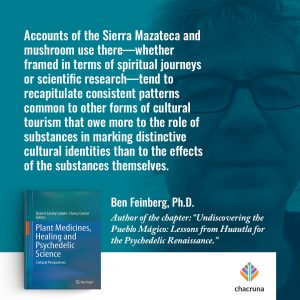 psychedelic mushrooms are probably consistent across individuals in different cultural and historical settings, the ways in which they are perceived to work, the contexts in which they are taken, the problems they are perceived to address, and the degree to which their efficacy is assessed are all discursively constructed in ways that are fluid and contested, and may vary greatly. The town of Huautla de Jimenez, in the Sierra Mazateca of Oaxaca, Mexico, is well known as a space where the use of mushrooms is culturally elaborated, and foreign and urban visitors have come to the area to use them since the 1950s, producing an often-imbalanced cross-cultural dialogue about their effects. In this chapter, I provide a brief overview, based on 25 years of ethnographic research, of the different expectations of visitors and Mazatec-speakers, and the changes in Mazatec discourse about mushroom use. I suggest that the Western discourse about the “therapeutic value” of mushroom use, with its focus on individual wellness, often assumes a universality that erases context and the ways in which Mazatec-speakers understand the value of the “child saints.” At the same time, these differences do not forestall the possibility of productive engagement and collaborative research between Mazatec-speakers and outsiders
psychedelic mushrooms are probably consistent across individuals in different cultural and historical settings, the ways in which they are perceived to work, the contexts in which they are taken, the problems they are perceived to address, and the degree to which their efficacy is assessed are all discursively constructed in ways that are fluid and contested, and may vary greatly. The town of Huautla de Jimenez, in the Sierra Mazateca of Oaxaca, Mexico, is well known as a space where the use of mushrooms is culturally elaborated, and foreign and urban visitors have come to the area to use them since the 1950s, producing an often-imbalanced cross-cultural dialogue about their effects. In this chapter, I provide a brief overview, based on 25 years of ethnographic research, of the different expectations of visitors and Mazatec-speakers, and the changes in Mazatec discourse about mushroom use. I suggest that the Western discourse about the “therapeutic value” of mushroom use, with its focus on individual wellness, often assumes a universality that erases context and the ways in which Mazatec-speakers understand the value of the “child saints.” At the same time, these differences do not forestall the possibility of productive engagement and collaborative research between Mazatec-speakers and outsiders
Watch the presentation by Ben Feinberg at Psychedelic Science 2017 here
- The Use of Salvia divinorum from a Mazatec Perspective
Ana Elda Maqueda
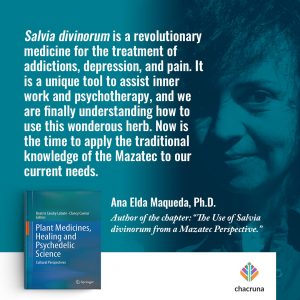 Salvia divinorum is a medicinal and psychoactive plant endemic to the Mazatec Sierra of Oaxaca, Mexico. The Mazatec people have been using the leaves for centuries in ceremonies as a treatment for arthritis and inflammation, headaches, gastrointestinal problems, and addiction to cocaine, alcohol and inhalants, among others uses. Recent pharmacological findings support these different applications. The active principle of salvia, the terpene salvinorin-A, is a uniquely potent and highly selective kappa-opioid receptor agonist, and, as such, it has tremendous potential for the development of a wide variety of valuable medications. Among them, the most promising include safe non-addictive analgesics, antidepressants, anti-inflammatories, neuroprotectors, short-acting anesthetics that do not depress respiration, medications for the treatment of addiction to stimulants and alcohol, drugs to treat disorders characterized by alterations in perception, including schizophrenia, Alzheimer’s disease, and bipolar disorder, and drugs to treat diverse types of tumors. The Mazatec consider salvia to be a very powerful plant-being that should be treated with utmost respect, and the preparation for the ceremony requires a strict regimen. The Mazatec chew the fresh leaves at night while chanting and praying. In the Western use of salvia, the dry leaves are potentiated in extracts to be smoked. A lack of information about the appropriate doses and other considerations while smoking the extracts could result in overwhelming experiences due to the high potency and fast onset of the substance. For the Mazatec, smoking the plant is not the preferred mode. How could we create a bridge between the two perspectives? Besides salvinorin-A, at least 10 other compounds are present in the leaves. Is it a good idea to use only one of them, or are we missing something in the Western use? In this chapter, I will try to clarify the best ways to use salvia for medicinal, psychotherapeutic, and inner exploration purposes.
Salvia divinorum is a medicinal and psychoactive plant endemic to the Mazatec Sierra of Oaxaca, Mexico. The Mazatec people have been using the leaves for centuries in ceremonies as a treatment for arthritis and inflammation, headaches, gastrointestinal problems, and addiction to cocaine, alcohol and inhalants, among others uses. Recent pharmacological findings support these different applications. The active principle of salvia, the terpene salvinorin-A, is a uniquely potent and highly selective kappa-opioid receptor agonist, and, as such, it has tremendous potential for the development of a wide variety of valuable medications. Among them, the most promising include safe non-addictive analgesics, antidepressants, anti-inflammatories, neuroprotectors, short-acting anesthetics that do not depress respiration, medications for the treatment of addiction to stimulants and alcohol, drugs to treat disorders characterized by alterations in perception, including schizophrenia, Alzheimer’s disease, and bipolar disorder, and drugs to treat diverse types of tumors. The Mazatec consider salvia to be a very powerful plant-being that should be treated with utmost respect, and the preparation for the ceremony requires a strict regimen. The Mazatec chew the fresh leaves at night while chanting and praying. In the Western use of salvia, the dry leaves are potentiated in extracts to be smoked. A lack of information about the appropriate doses and other considerations while smoking the extracts could result in overwhelming experiences due to the high potency and fast onset of the substance. For the Mazatec, smoking the plant is not the preferred mode. How could we create a bridge between the two perspectives? Besides salvinorin-A, at least 10 other compounds are present in the leaves. Is it a good idea to use only one of them, or are we missing something in the Western use? In this chapter, I will try to clarify the best ways to use salvia for medicinal, psychotherapeutic, and inner exploration purposes.
- The Therapeutic Potential of Kratom
Hayden Griffin, III
Kratom is one of many traditional drugs that has recently 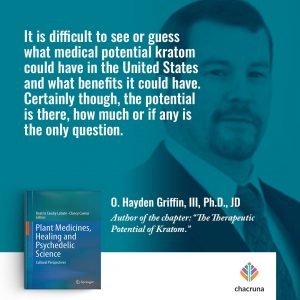 gained attention in the West. Kratom comes from the Korth tree (Mitragynine speciosa), a plant native to Africa and Southeast Asia, but most commonly found in Thailand and Malaysia. While the first scientific reference to the plant occurred in 1836, people indigenous to Southeast Asia have used kratom for at least hundreds of years. Kratom leaves contain over twenty alkaloids. Two of these alkaloids, mitragynine and 7-hydroxymitragynine (7-OH), contain psychoactive properties. However, one of the things that makes kratom so interesting is that mitragynine has stimulant properties, while 7-OH has narcotic properties. Such divergent effects within a plant are rare. Within Southeast Asia, traditional kratom use includes the treatment of malaria, cough, hypertension, diarrhea, depression, analgesia, fever, and even as an opiate substance or to help patients through opiate withdrawal. The diversity of medical utility of kratom has not only led to medical research of the plant in the United States, but many Americans have begun to use it as well for a variety of medicinal and recreational purposes. To date, the complete medical utility of kratom has yet to be realized. So far, few individual states have regulated kratom, but the Drug Enforcement Administration (DEA) has expressed some intent to do so.
gained attention in the West. Kratom comes from the Korth tree (Mitragynine speciosa), a plant native to Africa and Southeast Asia, but most commonly found in Thailand and Malaysia. While the first scientific reference to the plant occurred in 1836, people indigenous to Southeast Asia have used kratom for at least hundreds of years. Kratom leaves contain over twenty alkaloids. Two of these alkaloids, mitragynine and 7-hydroxymitragynine (7-OH), contain psychoactive properties. However, one of the things that makes kratom so interesting is that mitragynine has stimulant properties, while 7-OH has narcotic properties. Such divergent effects within a plant are rare. Within Southeast Asia, traditional kratom use includes the treatment of malaria, cough, hypertension, diarrhea, depression, analgesia, fever, and even as an opiate substance or to help patients through opiate withdrawal. The diversity of medical utility of kratom has not only led to medical research of the plant in the United States, but many Americans have begun to use it as well for a variety of medicinal and recreational purposes. To date, the complete medical utility of kratom has yet to be realized. So far, few individual states have regulated kratom, but the Drug Enforcement Administration (DEA) has expressed some intent to do so.
- Bubbling with Controversy: Legal Troubles for Ceremonial Ayahuasca Circles in the U.S.
Kevin Feeney, Beatriz Caiuby Labate & J. Hamilton Hudson
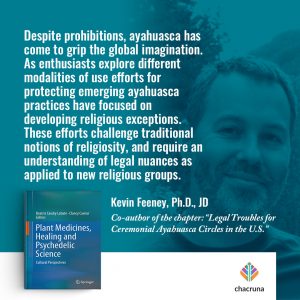 The use of ayahuasca has been spreading rapidly worldwide, however, no current statistics are available to provide a comprehensive understanding of the scope or pace of this expansion. In the UnitedStates, the expansion has included the appearance of the Brazilian ayahuasca religions (Santo Daime and União do Vegetal [UDV]), underground ceremonialcircles, workshops with indigenousAmazonian shamans, and spiritualretreat centers. Part of the trend has been the emergence of groups and organizations that publicly advertise “legal” ayahuasca
The use of ayahuasca has been spreading rapidly worldwide, however, no current statistics are available to provide a comprehensive understanding of the scope or pace of this expansion. In the UnitedStates, the expansion has included the appearance of the Brazilian ayahuasca religions (Santo Daime and União do Vegetal [UDV]), underground ceremonialcircles, workshops with indigenousAmazonian shamans, and spiritualretreat centers. Part of the trend has been the emergence of groups and organizations that publicly advertise “legal” ayahuasca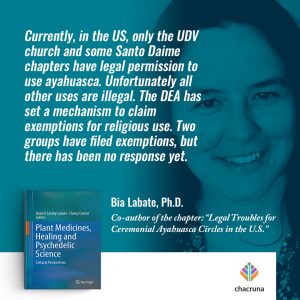 ceremonies and retreats. This chapter maps the existence of a series of organizations and actors who have controversially claimed legal protection through incorporationas “branches” of the Native AmericanChurch. These include: Oklevueha Native American Church (ONAC), Soul Quest, and Ayahuasca
ceremonies and retreats. This chapter maps the existence of a series of organizations and actors who have controversially claimed legal protection through incorporationas “branches” of the Native AmericanChurch. These include: Oklevueha Native American Church (ONAC), Soul Quest, and Ayahuasca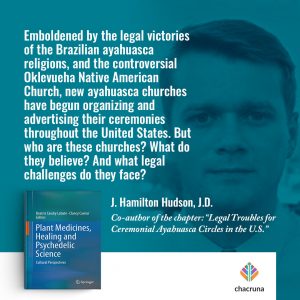 Healings. The legality and authenticity of these churches is reviewed in light of governing law, such as the First Amendment of the U.S. Constitution, the ReligiousFreedomRestoration Act (RFRA),the Controlled Substances Act (CSA), and pertinent court cases involving the UDV and Santo Daime, as well as ethnographic accounts of the historical Native American Church. Finally, we examine a petition for a religiousexemption from the CSA from Ayahuasca Healings. This chapter provides the reader with two things; (1) a brief overview and analysis of new and emerging ayahuasca churches in the United States, and (2) a roadmap of legal barriers and potentialities facing emerging ceremonial ayahuasca circles
Healings. The legality and authenticity of these churches is reviewed in light of governing law, such as the First Amendment of the U.S. Constitution, the ReligiousFreedomRestoration Act (RFRA),the Controlled Substances Act (CSA), and pertinent court cases involving the UDV and Santo Daime, as well as ethnographic accounts of the historical Native American Church. Finally, we examine a petition for a religiousexemption from the CSA from Ayahuasca Healings. This chapter provides the reader with two things; (1) a brief overview and analysis of new and emerging ayahuasca churches in the United States, and (2) a roadmap of legal barriers and potentialities facing emerging ceremonial ayahuasca circles
Watch another presentation by Kevin Feeney (on a different topic) at Psychedelic Science 2017 here
- Integrating Plant Medicines and Psychiatry: Theory and Methods of a Model Clinic
Jordan Sloshower
Over the past two decades, scientific evidence of the safety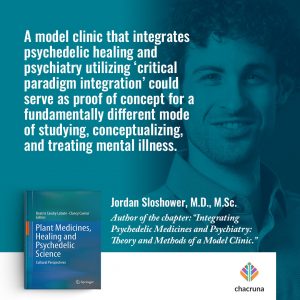 and therapeutic potential of plant medicines, such as ayahuasca and psilocybin, has grown significantly to the point where their eventual rescheduling and incorporation into formal psychiatric practice seems increasingly likely. However, this integration could unfold in a multitude of ways, reflecting differences in neurobiological, psychological, spiritual, indigenous, and other ontological understandings of what these substances are and how they exert their therapeutic effects. Attempts to reconcile divergent explanatory lenses and therapeutic approaches will present significant challenges to psychiatric theory and praxis as well as unique opportunities to develop new efficacious treatments, advance scientific knowledge, and promote justice and human rights. In order to achieve these objectives, a model research clinic would treat patients with plant medicines and complementary treatment modalities in a manner that a) respects and incorporates principles and practices from different traditions and paradigms, and b) fosters knowledge generation and transfer across paradigms. Such “critical paradigm integration” would employ interdisciplinary collaboration and reflexive critique in conjunction with contemporary scientific methodologies to unify various ways of understanding plant medicines and other integrative modalities, such as yoga, meditation, and sound therapy, and begin to elucidate best practices for treating various conditions. The resulting clinic would have the capacity to tailor treatments to individual patient needs and learn how variables related to the treatments themselves (dose, preparation, frequency) and to set and setting (use of psychotherapy, music, nature exposure, diet, and group or ceremonial ingestion) affect subjective experience and outcomes.
and therapeutic potential of plant medicines, such as ayahuasca and psilocybin, has grown significantly to the point where their eventual rescheduling and incorporation into formal psychiatric practice seems increasingly likely. However, this integration could unfold in a multitude of ways, reflecting differences in neurobiological, psychological, spiritual, indigenous, and other ontological understandings of what these substances are and how they exert their therapeutic effects. Attempts to reconcile divergent explanatory lenses and therapeutic approaches will present significant challenges to psychiatric theory and praxis as well as unique opportunities to develop new efficacious treatments, advance scientific knowledge, and promote justice and human rights. In order to achieve these objectives, a model research clinic would treat patients with plant medicines and complementary treatment modalities in a manner that a) respects and incorporates principles and practices from different traditions and paradigms, and b) fosters knowledge generation and transfer across paradigms. Such “critical paradigm integration” would employ interdisciplinary collaboration and reflexive critique in conjunction with contemporary scientific methodologies to unify various ways of understanding plant medicines and other integrative modalities, such as yoga, meditation, and sound therapy, and begin to elucidate best practices for treating various conditions. The resulting clinic would have the capacity to tailor treatments to individual patient needs and learn how variables related to the treatments themselves (dose, preparation, frequency) and to set and setting (use of psychotherapy, music, nature exposure, diet, and group or ceremonial ingestion) affect subjective experience and outcomes.
Watch the presentation by Jordan Sloshower at Psychedelic Science 2017 here
- Whole Organisms or Pure Compounds? Entourage Effect Versus Drug Specificity
Sidarta Ribeiro
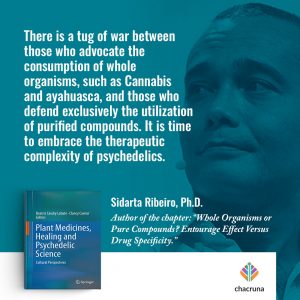 As the therapeutic use of sacred plants and fungi becomes increasingly accepted by Western medicine, a tug of war has been taking place between those who advocate the traditional consumption of whole organisms, and those who defend exclusively the utilization of purified compounds. The attempt to reduce organisms to single active principles is challenged by the sheer complexity of traditional medicine. Ayahuasca, for example, is a concoction of at least two plant species containing multiple psychoactive substances with complex interactions. Similarly, cannabis contains dozens of psychoactive substances whose specific combinations in different strains correspond to different types of therapeutic and cognitive effects. The “entourage effect,” a term coined in 1998 by Raphael Mechoulam and Shimon Ben-Shabat, refers to the synergistic effects of the multiple compounds present in whole organisms, which may potentiate clinical efficacy while attenuating side effects. In opposition to this view, mainstream pharmacology is adamant about the need to use purified substances, presumably more specific and safe. In this talk, I will review the evidence on both sides to discuss the scientific, economic, and political implications of this controversy.
As the therapeutic use of sacred plants and fungi becomes increasingly accepted by Western medicine, a tug of war has been taking place between those who advocate the traditional consumption of whole organisms, and those who defend exclusively the utilization of purified compounds. The attempt to reduce organisms to single active principles is challenged by the sheer complexity of traditional medicine. Ayahuasca, for example, is a concoction of at least two plant species containing multiple psychoactive substances with complex interactions. Similarly, cannabis contains dozens of psychoactive substances whose specific combinations in different strains correspond to different types of therapeutic and cognitive effects. The “entourage effect,” a term coined in 1998 by Raphael Mechoulam and Shimon Ben-Shabat, refers to the synergistic effects of the multiple compounds present in whole organisms, which may potentiate clinical efficacy while attenuating side effects. In opposition to this view, mainstream pharmacology is adamant about the need to use purified substances, presumably more specific and safe. In this talk, I will review the evidence on both sides to discuss the scientific, economic, and political implications of this controversy.
Watch the presentation by Sidarta Ribeiro at Psychedelic Science 2017 here
- The Placebo Paradox
Katherine Hendy
The re-vitalization of clinical trials with psychedelics has 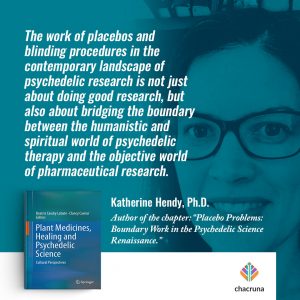 produced an exciting new array of studies investigating different combinations of therapeutic substances and diagnoses. Beyond the important bureaucratic negotiations that have taken place to gain approval for these studies, this new wave of studies is also negotiating a new methodological landscape of clinical research. When researchers Humphry Osmond and Abram Hoffer were studying the use of hallucinogens in Saskatchewan in the 1950’s, their research was published as case studies. Today, placebo-controlled randomized studies are now the standard for research with psychopharmaceuticals. Because psychedelic therapy seeks to induce a radical change in consciousness—to make a subject feel different from her everyday self—blinding these studies has emerged as a methodological sticking point. However, this paper argues, that it is also a rich site for interrogating the paradoxes of placebo effects more generally. Anthropology has generally engaged with the placebo as inert: either as an example of the power of symbolic healing within Western medicine, or as the ethically fraught territory of non-treatment. In contrast, this paper frames placebos as anything but inert; they are heavily charged with efficacy within the logic of the clinical trial. Drawing upon ethnographic research with clinical researchers from the Multidisciplinary Association for Psychedelic Studies (MAPS) and the history of the use of placebos in medicine and in research, this paper will explore how contemporary studies are negotiating the placebo paradox.
produced an exciting new array of studies investigating different combinations of therapeutic substances and diagnoses. Beyond the important bureaucratic negotiations that have taken place to gain approval for these studies, this new wave of studies is also negotiating a new methodological landscape of clinical research. When researchers Humphry Osmond and Abram Hoffer were studying the use of hallucinogens in Saskatchewan in the 1950’s, their research was published as case studies. Today, placebo-controlled randomized studies are now the standard for research with psychopharmaceuticals. Because psychedelic therapy seeks to induce a radical change in consciousness—to make a subject feel different from her everyday self—blinding these studies has emerged as a methodological sticking point. However, this paper argues, that it is also a rich site for interrogating the paradoxes of placebo effects more generally. Anthropology has generally engaged with the placebo as inert: either as an example of the power of symbolic healing within Western medicine, or as the ethically fraught territory of non-treatment. In contrast, this paper frames placebos as anything but inert; they are heavily charged with efficacy within the logic of the clinical trial. Drawing upon ethnographic research with clinical researchers from the Multidisciplinary Association for Psychedelic Studies (MAPS) and the history of the use of placebos in medicine and in research, this paper will explore how contemporary studies are negotiating the placebo paradox.
Watch the presentation by Katherine Hendy at Psychedelic Science 2017 here
- Psychedelic Naturalism and Interspecies Alliance: Views from the Emerging Radical Mycology Movement
Joanna Steinhardt
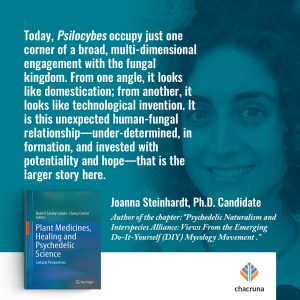 Radical (or do-it-yourself, a.k.a. DIY) mycology is a movement that has emerged in the last decade in North America, concentrated in the Pacific Northwest and Northern California. Radical mycologists specialize in easy and accessible methods of mushroom cultivation and mycological experimentation. They draw primarily on home cultivation methods innovated by Psilocybe cultivators in the 1970s and on creative applications popularized by commercial mycologist and psychedelic enthusiast Paul Stamets in the 2000s. In loosely organized volunteer-run groups, they promote a citizen science approach, including informal education and grassroots ecological restoration practices (e.g., myco-remediation). Though their agenda is broad, their engagement with psilocybin-active species is one underlying commonality. Paraphrasing Stamets, for many, Psilocybe cubensis was their “gateway mushroom.” As a counterpoint to the newfound visibility and legitimacy of psilocybin, radical mycology attests to the significant permeation of psychedelia into North American countercultures in the last half-century and its influence on ideas about science, technology, and nonhuman life. Drawing on ethnographic fieldwork in the San Francisco Bay Area and the Pacific Northwest, this chapter describes how this movement builds on the mycological and technical know-how of Psilocybe cultivation. Shaped by the constraints of criminalization, the unique morphology of fungi, and a countercultural ethos, this emergent human-fungal relationship eludes modern categories (e.g., wild/domesticated, subject/object). It is best understood as an entanglement of interspecies trajectories as these treasured fungi co-evolve into our homes, labs, gardens, and public parks.
Radical (or do-it-yourself, a.k.a. DIY) mycology is a movement that has emerged in the last decade in North America, concentrated in the Pacific Northwest and Northern California. Radical mycologists specialize in easy and accessible methods of mushroom cultivation and mycological experimentation. They draw primarily on home cultivation methods innovated by Psilocybe cultivators in the 1970s and on creative applications popularized by commercial mycologist and psychedelic enthusiast Paul Stamets in the 2000s. In loosely organized volunteer-run groups, they promote a citizen science approach, including informal education and grassroots ecological restoration practices (e.g., myco-remediation). Though their agenda is broad, their engagement with psilocybin-active species is one underlying commonality. Paraphrasing Stamets, for many, Psilocybe cubensis was their “gateway mushroom.” As a counterpoint to the newfound visibility and legitimacy of psilocybin, radical mycology attests to the significant permeation of psychedelia into North American countercultures in the last half-century and its influence on ideas about science, technology, and nonhuman life. Drawing on ethnographic fieldwork in the San Francisco Bay Area and the Pacific Northwest, this chapter describes how this movement builds on the mycological and technical know-how of Psilocybe cultivation. Shaped by the constraints of criminalization, the unique morphology of fungi, and a countercultural ethos, this emergent human-fungal relationship eludes modern categories (e.g., wild/domesticated, subject/object). It is best understood as an entanglement of interspecies trajectories as these treasured fungi co-evolve into our homes, labs, gardens, and public parks.
Watch the presentation by Joanna Steinhardt at Psychedelic Science 2017 here
- Plant Knowledges: Indigenous Approaches and Interspecies Listening Toward Decolonizing Ayahuasca Research
Laura Dev
When producing knowledge about ayahuasca and other medicinal plants, it can be important to assess what the role of plants themselves are in our practices, and how we interact with plant agencies. This chapter explores the epistemological assumptions that are required for different types of knowledge-making practices, and how these practices create different types of relationships between knower and known. Scientific practices, classically, rely on a subject-object relationship between researcher and researched; but, is this a necessary condition for science? Among Shipibo healers, learning is one of the main reasons to drink ayahuasca. Accordingly, ayahuasca is not only useful for revealing diagnoses of illnesses and the proper way to heal them, but it also can facilitate communication with other plants, which in turn generate learning about botanical knowledge. Plant “dietas” are the primary practice by which Shipibo healers produce botanical knowledge, in which plants are seen as teachers and active co-participants in the production of knowledge. I examine the entanglements and tensions that exist among various knowledge-making practices, and discuss how these relationships can determine the types of knowledge that can be produced. I take a multispecies perspective to investigate how plants and humans both contribute to producing botanical knowledge, and the dynamic relationships that are formed through these practices.
medicinal plants, it can be important to assess what the role of plants themselves are in our practices, and how we interact with plant agencies. This chapter explores the epistemological assumptions that are required for different types of knowledge-making practices, and how these practices create different types of relationships between knower and known. Scientific practices, classically, rely on a subject-object relationship between researcher and researched; but, is this a necessary condition for science? Among Shipibo healers, learning is one of the main reasons to drink ayahuasca. Accordingly, ayahuasca is not only useful for revealing diagnoses of illnesses and the proper way to heal them, but it also can facilitate communication with other plants, which in turn generate learning about botanical knowledge. Plant “dietas” are the primary practice by which Shipibo healers produce botanical knowledge, in which plants are seen as teachers and active co-participants in the production of knowledge. I examine the entanglements and tensions that exist among various knowledge-making practices, and discuss how these relationships can determine the types of knowledge that can be produced. I take a multispecies perspective to investigate how plants and humans both contribute to producing botanical knowledge, and the dynamic relationships that are formed through these practices.
Watch the presentation by Laura Dev at Psychedelic Science 2017 here
- DMT, Liminality and Hyperspace
Graham St John
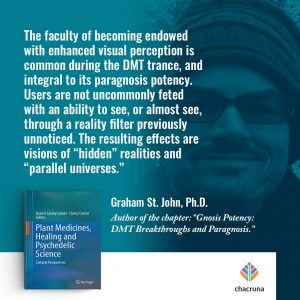 Known to produce out-of-body states and profound changes in sensory perception, mood, and thought, DMT (N,N-dimethyltryptamine) is a potent, short-lasting tryptamine that has experienced growing appeal in the last decade, independent of ayahuasca, the Amazonian visionary brew in which it is an integral ingredient. Investigating user reports available online and from other sources, this paper focuses on the “breakthrough” event commonly associated with the DMT trance. While different modalities of DMT use/experience—gnostic, therapeutic, and recreational—inform the breakthrough “event,” I explore some of the commonalities: extraordinary transpersonal experience, perceived contact with “entities,” and the transmission of visual language. Significantly, for a global networked community whose participants venerate DMT among a variety of entheogens, the breakthrough event enables reconnection with the natural world from which humanity is imagined to have grown alienated—a sensibility often revealed or affirmed through personal exposure to the liminal effects of DMT and other tryptamines. Examination of this “event” offers insight on the liminal ontology of tryptamines—an “entheoliminality” given primary expression in reported travels in “hyperspace,” an ontological realm that appears to feature ritual-like modes of transmission. The paper concludes with an exploration of these modes in this transitional terrain.
Known to produce out-of-body states and profound changes in sensory perception, mood, and thought, DMT (N,N-dimethyltryptamine) is a potent, short-lasting tryptamine that has experienced growing appeal in the last decade, independent of ayahuasca, the Amazonian visionary brew in which it is an integral ingredient. Investigating user reports available online and from other sources, this paper focuses on the “breakthrough” event commonly associated with the DMT trance. While different modalities of DMT use/experience—gnostic, therapeutic, and recreational—inform the breakthrough “event,” I explore some of the commonalities: extraordinary transpersonal experience, perceived contact with “entities,” and the transmission of visual language. Significantly, for a global networked community whose participants venerate DMT among a variety of entheogens, the breakthrough event enables reconnection with the natural world from which humanity is imagined to have grown alienated—a sensibility often revealed or affirmed through personal exposure to the liminal effects of DMT and other tryptamines. Examination of this “event” offers insight on the liminal ontology of tryptamines—an “entheoliminality” given primary expression in reported travels in “hyperspace,” an ontological realm that appears to feature ritual-like modes of transmission. The paper concludes with an exploration of these modes in this transitional terrain.
Watch the presentation by Graham St John at Psychedelic Science 2017 here
Biography authors:
Alexander Dawson is a historian of modern Mexico, and is Professor of History and International Studies at Simon Fraser University in Vancouver, Canada. He is the author of three books, including Latin American Since Independence: A History with Primary Sources (Routledge, 2011, 2014), First World Dreams: Mexico Since 1989 (Zed Books, 2006), and Indian and Nation in Revolutionary Mexico (Arizona, 2004), and has published essays in Latin American Perspectives, the Journal of Latin American Studies, The Americas, and the Hispanic American Historical Review. He is currently working on a book titled The Peyote Effect: Making Race Along the US-Mexican Border (under contract with the University of California Press), which examines the ways peyote, Whiteness, and Indianness have been linked over time in Mexico and the United States by indigenous peoples, ecclesiastical authorities, government officials, and others.
Laura Dev is a PhD candidate at the University of California, Berkeley, in environmental science, policy, and management. Her studies are focused at the intersection of political ecology; science, technology and society (STS); and ethnobotany. Using a multi-species ethnography approach to investigate relationships among medicinal plants and humans, she hopes her work may help to inform how Shipibo communities can better manage their cultural and botanical resources in order to receive greater benefits from the commoditization of their plants and rituals. Her field research is based between Ucayali, Peru and California. Laura holds an MS in ecology from Colorado State University.
Erika Dyck is Professor of History and a Canada Research Chair in Medical History at the University of Saskatchewan in Canada. Her research has concentrated on the history of madness, addiction, drug experimentation, eugenics, and psychiatric institutionalization in Canada over the twentieth century. Her first book, Psychedelic Psychiatry: LSD from Clinic to Campus (Johns Hopkins, 2008, republished in 2011 by University of Manitoba Press), explored the history of LSD experimentation in western Canada, trials that introduced the word “psychedelic” and promoted LSD as a treatment for alcoholism. More recently, she has been examining the history of peyote on the Canadian prairies; particularly, in encounters between members of the Native American Church and local clinical scientists in the 1950s, including an edited book, Culture’s Catalyst: Encounters with Peyote and the Native American Church in Canada (University of Manitoba Press, 2016). Her new work considers the role of history in the psychedelic renaissance.
Ben Feinberg received a PhD in anthropology from the University of Texas at Austin in 1996. He has been in engaged in research in the Sierra Mazateca region of Oaxaca, where he first visited in 1987, for the past 23 years, and is the author of The Devil’s Book of Culture: History, Mushrooms, and Caves in Southern Mexico (University of Texas Press, 2003). He is a professor of cultural anthropology and the chair of the Division of Social Sciences at Warren Wilson College in Asheville, North Carolina.
Hayden Griffin, III is an assistant professor in the Department of Justice Sciences at the University of Alabama at Birmingham. He has a PhD from the University of Florida and a JD from the University of Richmond. His research interests are drug policy, corrections, and law & society. Of particular interest to him is the history of the formulation of drug policy, as well as the scheduling process. His research has been published in International Journal of Drug Policy, Journal of Psychoactive Drugs, Journal of Drug Issues, and Journal of Drug Education.
Hamilton Hudsonis a lawyer from the U.S.A., born and raised in Hong Kong. He earned his JD with an MS from Tulane University in New Orleans and his BA magna cum laude in anthropology from the University of Colorado, Boulder. He is currently Research Associate at the Ayahuasca Defense Fund (ADF).
Katherine Hendy is a cultural anthropologist specializing in studies of medicine and science and technology. Her doctoral fieldwork and dissertation studied a small tribe of clinical researchers based out of Santa Cruz, California and their efforts to develop the drug MDMA as a prescription pharmaceutical. Her dissertation draws primarily from participant observation fieldwork with the Multidisciplinary Association for Psychedelic Studies (MAPS) and explores the politics of clinical research. She is currently a visiting assistant professor at The Ohio State University in the Department of Comparative Studies where she teaches several courses on science technology and society.
Ana Elda Maqueda is an author, clinical psychologist, and a neuroscientist studying the medicinal and psychoactive plant Salvia divinorum and the ayahuasca brew at the Human Neuropsychopharmacology Research Group, at the Hospital de Sant Pau in Barcelona, Spain. She is also a fieldwork researcher specializing in Salvia divinorum, and has spent the last six years exploring the Mazatec Sierra, thoroughly investigating the current uses of this plant. During her fieldwork, she lived with Mazatec families, learning from traditional doctors and healers, and contributed her support to the preservation of their language, habitat, and customs. She is the founder of the non-profit Xkà, which aims to recuperate the Mazatec knowledge about salvia, as well as their cosmovision and associated rituals.
Joanna Steinhardt is a PhD candidate in the anthropology department at University of California, Santa Barbara. She is also the recipient of a master’s degree in cultural studies from Hebrew University in Jerusalem. Her master’s thesis was on an American-Jewish mystical religious revival in Israel and Palestine. She is writing her dissertation on do-it-yourself (DIY) mycology based on fieldwork in the San Francisco Bay Area and the Pacific Northwest. She also works as a communications consultant for MycoWorks, a San Francisco-based company developing sustainable material from fungi. Her interests are in contemporary spirituality, secularity, popular and DIY science, speculative futures, and multispecies ethnography.
Sidarta Ribeiro is Full Professor of Neuroscience and Director of the Brain Institute at the Universidade Federal do Rio Grande do Norte. He holds a bachelor’s degree in biology from the Universidade de Brasília (1993), a master’s degree in biophysics from the Universidade Federal do Rio de Janeiro (1994) and a Ph.D. in animal behavior from the Rockefeller University (2000), with post-doctoral studies in neurophysiology at Duke University (2005). He has experience in neuroethology, molecular neurobiology, and systems neurophysiology, with an interest in the following subjects: memory, sleep and dreams; neuronal plasticity; vocal communication; symbolic competence in non-human animals; drug policy, and neuroeducation. From 2009–2011, he served as Secretary of the Brazilian Society for Neuroscience and Behavior. From 2011–2015, he served as Chair of the Brazilian Regional Committee of the Pew Latin American Fellows Program in the Biomedical Sciences, and member of the Steering Committee of the Latin American School for Education, Cognitive and Neural Sciences (LA School). He is also a senior research associate of the FAPESP Research Center for Innovation and Diffusion in Neuromathematics, and a member of the Advisory Board of the Brazilian Platform for Drug Policy.
Jordan Sloshower is currently a resident physician in the Department of Psychiatry at Yale University. He was born and raised in Winnipeg, Canada, and completed a master’s degree in medical anthropology prior to entering medical school at Yale. While a medical student, he pursued global health research and clinical opportunities in India, Nepal, Ecuador, Peru, and South Africa. His current research focuses on the therapeutic application of psychedelic substances, while his clinical interests include mental health system development in resource-poor settings and integrative psychiatry, especially utilizing mindfulness-based psychotherapy.
Graham St John, PhD, is an Australian cultural anthropologist specializing in event-cultures and entheogens. Among his eight books are Mystery School in Hyperspace: A Cultural History of DMT (North Atlantic Books/Evolver, 2015) and Global Tribe: Technology, Spirituality and Psytrance (Equinox, 2012). He is founding Executive Editor of Dancecult: Journal of Electronic Dance Music Culture, and he is currently Senior Researcher for Burning Progeny, a comparative ethnographic study of the Burning Man movement in Europe, based in the Social Sciences, University of Fribourg, Switzerland. His website is: www.edgecentral.net.
Take a minute to browse our stock:
Did you enjoy reading this article?
Please support Chacruna's work by donating to us. We are an independent organization and we offer free education and advocacy for psychedelic plant medicines. We are a team of dedicated volunteers!
Can you help Chacruna advance cultural understanding around these substances?


